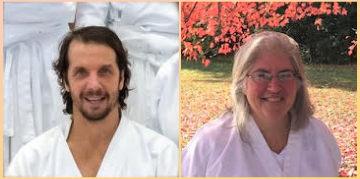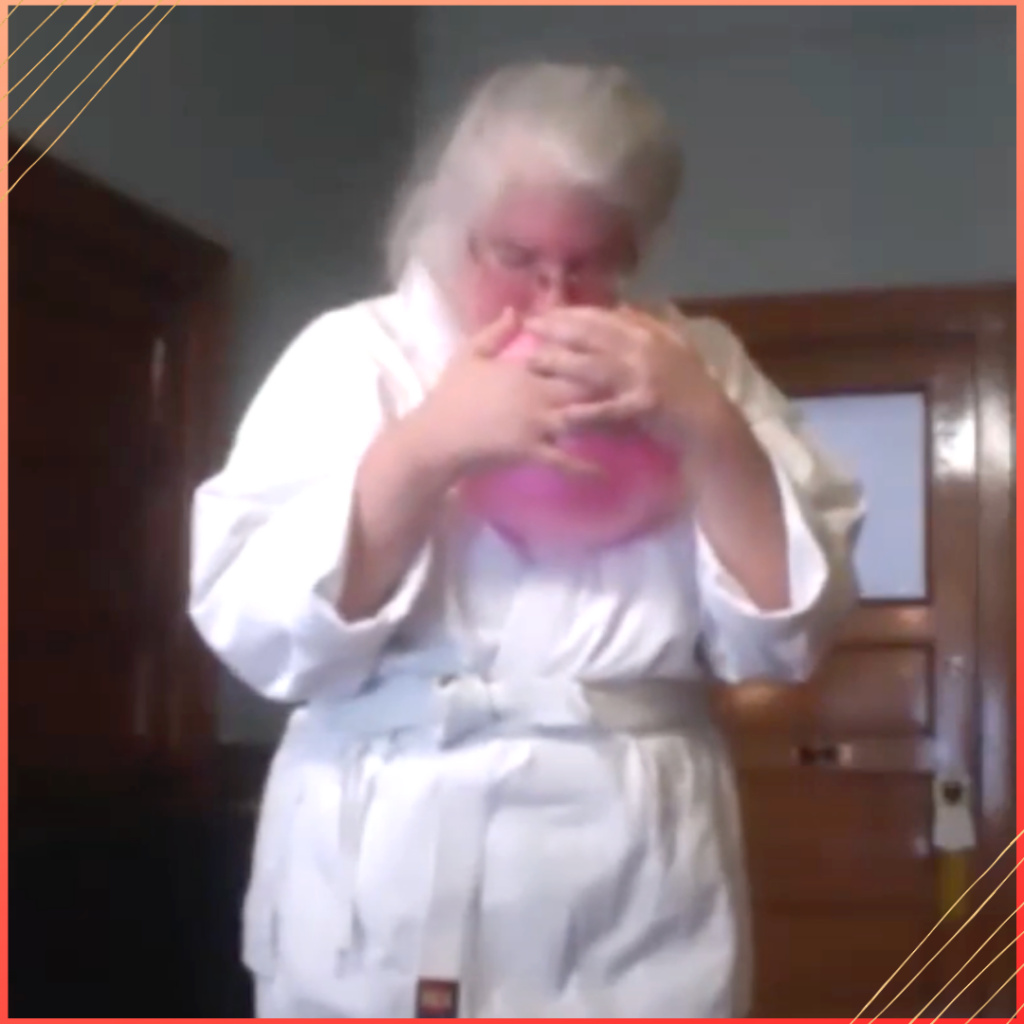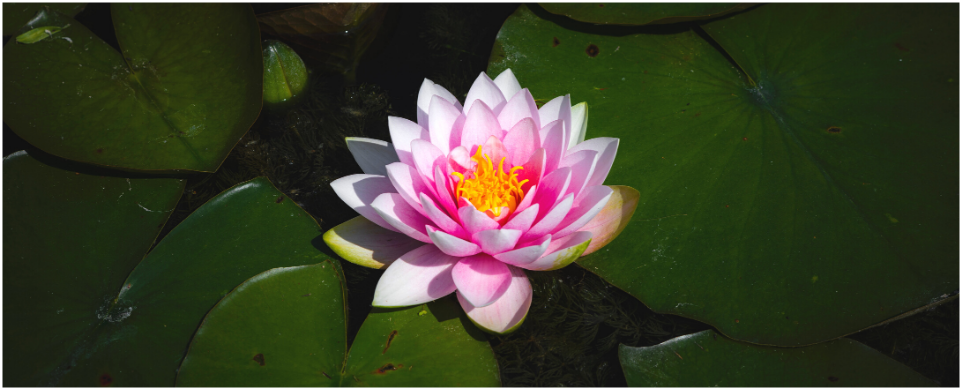by Connie Borden, Shin Aoki and Derk Richardson
New for Shintaido in 2021 was PacShin Kangeiko via Zoom. PacShin offered three keiko on three separate days via Zoom so that Shintaido practitioners could deepen their study during this time of COVID pandemic. Thirty-seven people studied over the course of three days across two weekends—January 16, 17, and 23, 2021. Participants attended from the San Francisco Bay Area, the East Coast of the USA, the UK, Belgium, France, Italy, and the Czech Republic. The Kangeiko theme was “Opening to Life.”
Gianni Rossi, Shintaido General Instructor from Italy, and Margaret Guay, Shintaido Instructor from Shintaido Northeast, taught open-hand and Bokuto Shintaido techniques. Shin Aoki, Shintaido Senior Instructor, served as Director of Instruction. Shin, Cheryl Williams, and Derk Richardson were the organizers and Gasshuku managers. Sarah Baker edited all the Zoom recordings.

Derk opened Kangeiko with a poem. As a reflection on the theme, “Opening to Life,” he read this poem by Mary Oliver:
I DON’T WANT TO LIVE A SMALL LIFE
I don’t want to live a small life.
Open your eyes,
open your hands.
I have just come
from the berry fields, the sun
kissing me with its golden mouth all the way
(open your hands) and the wind winged clouds
following along thinking perhaps I might
feed them, but no I carry these heart-shapes
only to you. Look how many how small
but so sweet and maybe the last gift
I will ever bring to anyone in this
world of hope and risk, so do.
Look at me. Open your life, open your hands.
Gianni and Margaret co-taught all three keiko, leading us remotely from hundreds and thousands of miles away, yet with striking intimacy. In her teaching, Margaret combined her study of Body-Mind Centering with Shintaido, taking the idea of “opening” down to the cellular level of human development, and encouraging us to explore our body movements through all of our senses, especially while rolling on the floor! During the first keiko, she reminded us of the heart-mind connection as she demonstrated holding a ball in front of her chest, while resting her head on the ball.
During the second keiko, she led us through movements of the hand, directing our attention to how our fingers folded and unfolded, opened and closed, as we made fists, teaching about the evolution of our grip, and making the connection to how we do Tsuki. During the final keiko, Margaret had us reach through the windows of our computer, tablet, and phone screens and feel the connection with all the other Zoom participants.

Gianni taught both open-hand Shintaido and Bokuto, leading the first keiko’s extensive warmups with Bokuto. During the second keiko, he led in Eiko Dai, urging us to “go far, far, far” while running in place in our confined spaces, and he asked us to unmute ourselves so we could hear one another. The holding a “virtual” sword vertically, we reached out into the world and brought it back into our bodies, then we practiced with our actual swords. The keiko also included mochikai-e, receiving Tsuki with wakame, and more. During his closing keiko he encouraged to “fly” around our rooms with multi-directional cutting, and transported us back through time and space to a keiko he recalled with Master Instructor Masashi Minagawa in Italy, 12 or 15 years ago, taking us to the origins of Diamond Eight Cut. As Gianni “attacked” us with the various Diamond Eight cuts, we received on our side of our screens with wakame.
With Margaret leading, we finished with a meditative kata, originally shared by Michael Thompson, that brought together elements of Diamond Eight Cut and Ten-Point meditation, allowing us to settle into a deep contemplative space together through our bodies.
During the weekdays, four supplementary keiko were offered to all participants. Connie Borden taught two keiko focusing on Taimyo No Kata Part I and one keiko practicing Taimyo Part III. Bela Breslau’s keiko gave us the opportunity to deepen our study and exploration of Tenshingoso.
Opening the second weekend, Derk read the poem “The Guest House” by 13th-century Persian poet Mewlana-Jalaluddin-Rumi:
THE GUEST HOUSE
This being human is a guest house.
Every morning a new arrival.
A joy, a depression, a meanness,
some momentary awareness comes
As an unexpected visitor.
Welcome and entertain them all!
Even if they’re a crowd of sorrows,
who violently sweep your house
empty of its furniture,
still treat each guest honorably.
He may be clearing you out
for some new delight.
The dark thought, the shame, the malice,
meet them at the door laughing,
and invite them in.
Be grateful for whoever comes,
because each has been sent
as a guide from beyond.
And as part of the closing ceremony for our weeklong study of “Opening to Life,” Derk read another poem by Mary Oliver:
DON’T HESITATE
If you suddenly and unexpectedly feel joy, don’t hesitate.
Give in to it.
There are plenty of lives and whole towns destroyed or about to be.
We are not wise, and not very often kind.
And much can never be redeemed.
Still, life has some possibility left.
Perhaps this is its way of fighting back,
that sometimes something happens better than all the riches or power in the world.
It could be anything,
but very likely you notice it in the instant when love begins.
Anyway, that’s often the case.
Anyway, whatever it is, don’t be afraid of its plenty.
Joy is not made to be a crumb.
At the conclusion of each keiko, after a short break, participants were invited to stay online and engage in Q&A sessions with the instructors and open-ended discussions as a group. Although remote practice in separate spaces may not be an ideal way to practice Shintaido, Kangeiko via Zoom allowed Shintaido folks to practice with people they may never have met or hadn’t seen in a long time, and to converse and share our impressions of our experience.
All three of the formal 2021 PacShin Kangeiko keiko can be accessed and watched on the Shintaido of America YouTube channel.




Wonderful report that transports me back to January!